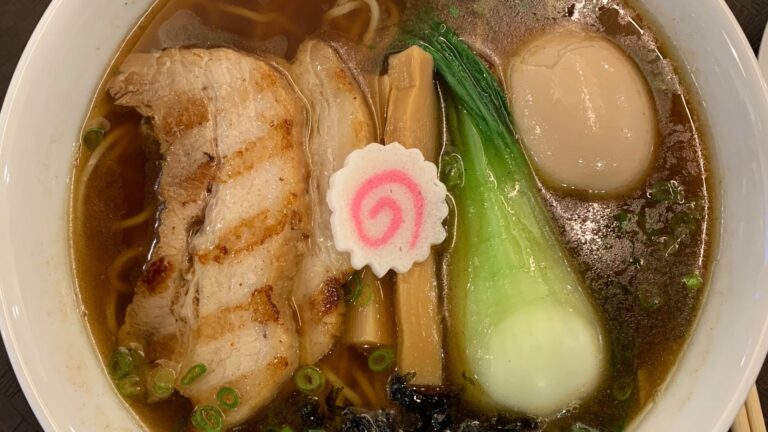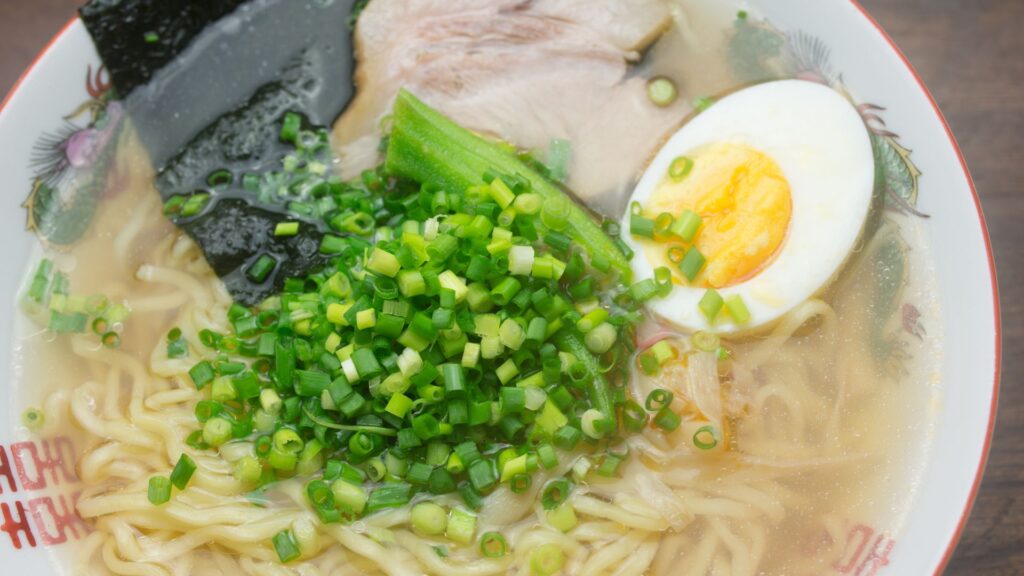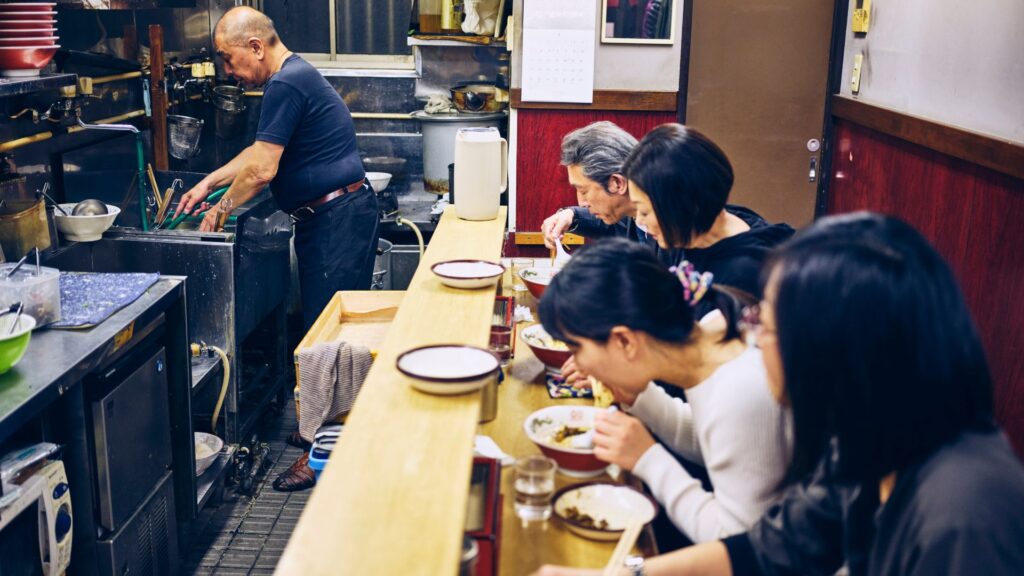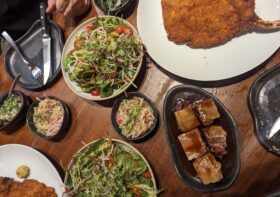Ramen 101: Types, Ingredients & Regions

Ramen is one of Japan’s most beloved and iconic dishes, and its many types offer a rich tapestry of flavors, ingredients, and cooking methods that vary across different regions. Here’s a breakdown of the main types of ramen, their ingredients, preparation methods, and regional influences.

1. Shoyu Ramen (Soy Sauce Ramen)
- Ingredients: The key element in Shoyu ramen is the soy saucebased tare (seasoning) mixed into the broth. The broth is usually a clear, brown color and can be made from chicken, vegetable, or sometimes pork bones, along with dried fish or kombu (seaweed) for depth.
- Cooking Method: The tare is added to the soup base, which is often a blend of light and savory flavors. The soup is simmered, allowing the soy sauce to infuse with the stock.
- Region: Shoyu ramen originated in Tokyo and is one of the most common types across Japan.
- Toppings: Common toppings include bamboo shoots (menma), scallions, nori (seaweed), and chashu (braised pork).

2. Shio Ramen (Salt Ramen)
- Ingredients: The broth in Shio ramen is seasoned with salt instead of soy sauce, making it a lighter, clearer broth. The stock is often made from chicken, pork, or fish bones, and the seasoning gives it a subtler taste compared to other ramen types.
- Cooking Method: Salt tare is carefully blended into the soup to avoid overwhelming the natural flavors of the broth. It usually results in a delicate, clean taste.
- Region: Shio ramen is commonly associated with Hakodate on the island of Hokkaido.
- Toppings: Typical toppings include boiled eggs, green onions, nori, and sometimes pickled plums for a salty-sour note.

3. Miso Ramen
- Ingredients: Miso ramen is defined by its miso (fermented soybean paste)-based broth, which is rich, hearty, and often thicker than shoyu or shio broths. The stock is usually made from chicken or pork, with added vegetables like corn or bean sprouts for extra texture and sweetness.
- Cooking Method: Miso tare is blended into a broth that is often robust and creamy. The soup is simmered for a longer time to allow the miso to fully incorporate, creating a fuller flavor profile.
- Region: This type of ramen comes from Sapporo, Hokkaido, and is perfect for the cold climate of northern Japan.
- Toppings: Common toppings include butter, corn, bean sprouts, chashu, and garlic to complement the deep, umami-rich broth.

4. Tonkotsu Ramen (Pork Bone Ramen)
- Ingredients: The hallmark of tonkotsu ramen is its creamy, white, and fatty broth, made by boiling pork bones for several hours until the marrow and collagen break down, creating a rich, milky consistency.
- Cooking Method: The pork bones are boiled at high heat for many hours (sometimes up to 12 hours or more) to extract a rich, fatty flavor. The soup is often quite thick and luxurious.
- Region: Tonkotsu ramen originated in Fukuoka, on the island of Kyushu, and is a signature dish of the Hakata region.
- Toppings: Traditional toppings include pickled ginger, sesame seeds, black garlic oil (mayu), and thinly sliced chashu. The noodles are often thin and straight to absorb the rich broth efficiently.

5. Tsukemen (Dipping Ramen)
- Ingredients: Tsukemen consists of thicker noodles served separately from a rich, concentrated dipping broth, which can be based on soy sauce, miso, or tonkotsu, often infused with additional flavors like vinegar or chili oil.
- Cooking Method: The noodles are served cold or at room temperature, while the broth is thick, savory, and warm. Diners dip the noodles into the broth before eating.
- Region: Tsukemen doesn’t have a specific regional origin but gained popularity in Tokyo during the mid-20th century.
- Toppings: Popular accompaniments include boiled eggs, pork belly slices, seaweed, and bamboo shoots.
6. Kitakata Ramen
- Ingredients: Kitakata ramen is known for its shoyu base and a broth that is usually made with a combination of pork bones and niboshi (dried sardines). The broth is mild, clear, and slightly fishy.
- Cooking Method: The noodles are chewy and thick, usually prepared to be slightly wavy. The broth is cooked gently to preserve the clarity and balance of flavors.
- Region: Originating from Kitakata, in Fukushima Prefecture, it’s known for its use of both fish and pork in the broth, which gives it a complex yet light flavor.
- Toppings: Toppings include green onions, menma, nori, and naruto (fish cakes), alongside the usual chashu.

7. Hakata Ramen
- Ingredients: Similar to Tonkotsu ramen but specifically from the Hakata region. The broth is rich, creamy, and pork-based, with thin noodles.
- Cooking Method: The tonkotsu broth is simmered for hours to break down the collagen in the pork bones, giving it a milky consistency.
- Region: Hakata, in Fukuoka, Kyushu. It’s known for its quick-cooking thin noodles, which are often served al dente.
- Toppings: Includes benishoga (pickled red ginger), sesame seeds, garlic, and chashu. Diners can often request kaedama, which means a second helping of noodles.

8. Tokyo Ramen
- Ingredients: This is a shoyu-based ramen that includes a light broth, typically made from chicken and vegetable stock, sometimes with pork or fish added. The soy sauce tare gives it a savory, balanced flavor.
- Cooking Method: The broth is simmered lightly, allowing the soy sauce flavor to shine without overwhelming the stock’s delicate taste.
- Region: As the name suggests, this ramen is a signature of Tokyo.
- Toppings: Standard toppings include menma, scallions, naruto, nori, and chashu.
What is the difference between Shoyu and Tokyo Ramen?
Tokyo ramen is a subtype of Shoyu ramen, with regional characteristics that emphasize a lighter broth and subtle flavors typical of the ramen found in the capital city.
- Regional Influence: Tokyo ramen is essentially a localized form of Shoyu ramen, originating specifically in Tokyo and characterized by its lighter, more delicate broth. Shoyu ramen, on the other hand, is more of a general category and can be found with different interpretations across Japan.
- Broth: While both use a soy sauce base, Tokyo ramen is typically lighter and cleaner in flavor, with a stronger influence from chicken stock compared to some heavier versions of Shoyu ramen that may use more pork or other umami-rich ingredients.
9. Onomichi Ramen
- Ingredients: Known for its shoyu base, combined with a pork-and-fish broth, and often includes a layer of pork fat on top. The broth has a deep, complex flavor.
- Cooking Method: The pork fat is added at the last minute, giving the soup a rich, almost oily texture. The noodles are typically medium-thick and chewy.
- Region: Hailing from Onomichi in Hiroshima Prefecture.
- Toppings: Often includes chashu, green onions, menma, and sometimes dried fish flakes.

Key Differences in Ingredients and Cooking:
- Broth Base: The most significant difference between ramen types lies in the base broth, which could be pork (tonkotsu), chicken (torigara), or fish (niboshi, katsuobushi) based, and whether it is flavored primarily with soy sauce (shoyu), salt (shio), or miso.
- Noodles: Depending on the region and ramen style, noodles can be thick or thin, straight or wavy, and vary in chewiness.
- Toppings: Standard toppings can vary by type and region, but often include chashu (braised pork), nori (seaweed), boiled eggs, bamboo shoots, and green onions.
Regional Influence:
- Northern Japan (Hokkaido): Rich, hearty ramen like Miso is popular due to the cold climate.
- Western Japan (Kyushu): Tonkotsu ramen dominates, known for its creamy, pork-based broth.
- Eastern Japan (Tokyo and surrounding areas): Lighter, shoyu-based ramen like Tokyo-style and Kitakata ramen prevail.
Our delicious journey through Japan’s diverse and flavorful world of noodles ends here. From the rich, savory depths of Tonkotsu ramen to the light, refreshing notes of Shio, we’ve explored how regional ingredients and cooking methods shape each unique bowl. Whether you’re indulging in a steaming bowl of Miso ramen topped with butter and corn or savoring the clean flavors of Tokyo ramen, each variety tells a story of culture, tradition, and passion. As you embark on your own ramen adventures, I hope this guide inspires you to try new flavors, appreciate the craftsmanship behind each bowl, and perhaps even find your personal favorite. Happy slurping!



Leave a Reply